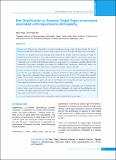Please use this identifier to cite or link to this item:
https://hdl.handle.net/20.500.14356/930Full metadata record
| DC Field | Value | Language |
|---|---|---|
| dc.contributor.author | Thapa, Raba | - |
| dc.contributor.author | Das, Taraprasad | - |
| dc.date.accessioned | 2023-04-06T08:42:48Z | - |
| dc.date.available | 2023-04-06T08:42:48Z | - |
| dc.date.issued | 2022 | - |
| dc.identifier.citation | ThapaR., & Das T. (2023). Risk Stratification on Systemic Target Organ Involvement Associated with Hypertensive Retinopathy. Journal of Nepal Health Research Council, 20(3), 577-585. https://doi.org/10.33314/jnhrc.v20i3.4273 | en_US |
| dc.identifier.issn | Print ISSN: 1727-5482; Online ISSN: 1999-6217 | - |
| dc.identifier.uri | http://103.69.126.140:8080/handle/20.500.14356/930 | - |
| dc.description | Original Article | en_US |
| dc.description.abstract | Abstract Background: Hypertensive retinopathy is a common complication among people with hypertension. The current study assessed the risk stratification on systemic target organ involvement of people with hypertensive retinopathy. Methods: In a hospital- based cross-sectional study conducted at a tertiary referral eye institute in Nepal, we included consecutive people ≥ 31 years with essential hypertension. Details of histories and systemic target organ involvements were documented. People with un-gradable retinal findings of hypertensive retinopathy and prior retinal surgery were excluded. All participants underwent comprehensive eye examination, including dilated fundus examination. Hypertensive retinopathy was classified by Modified Scheie classification. Multivariate analysis was performed to identify the risks for hypertensive retinopathy and target organ involvement. Results: The study recruited 312 subjects. The mean age was 63.68 ± 12.63 years. The mean duration of hypertension was 7.0 ± 6.5 years. Hypertensive retinopathy was detected in 83.7% (n=261) people and 63.5% (n= 198) had grade 1 hypertensive retinopathy. Target organ involvement was detected in 20.5% (n =64) people. These included cardiac (12.5%; n=39), central nervous (5.1%; n= 16), and renal (4.5%; n=14) systems. In multivariate analysis, concurrent hyperlipidaemia was significantly associated with hypertensive retinopathy and target organ involvement. Target organ involvement increased with the severity of hypertensive retinopathy. Conclusions: Over four-fifths of people with hypertension had hypertensive retinopathy and one-fifth had other systemic target organ involvements. Severity of hypertensive retinopathy and concurrent hyperlipidaemia were associated with target organ involvement. Hypertensive retinopathy can be considered for risk stratification to other target organ involvement in a clinical setting. Keywords: Hypertension; hypertensive retinopathy; Nepal; risk stratification; target organ. | en_US |
| dc.language.iso | en | en_US |
| dc.publisher | Nepal Health Research Council | en_US |
| dc.relation.ispartofseries | July-Sep, 2022;4273 | - |
| dc.subject | Hypertension | en_US |
| dc.subject | Hypertensive retinopathy | en_US |
| dc.subject | Nepal | en_US |
| dc.subject | Risk stratification | en_US |
| dc.subject | Target organ | en_US |
| dc.title | Risk Stratification on Systemic Target Organ Involvement Associated with Hypertensive Retinopathy | en_US |
| dc.type | Journal Article | en_US |
| Appears in Collections: | Vol 20 No 3 Issue 56 july-Sep, 2022 | |
Files in This Item:
| File | Description | Size | Format | |
|---|---|---|---|---|
| 4273-Manuscript-30760-1-10-20230314.pdf | Fulltext Article. | 237.38 kB | Adobe PDF |  View/Open |
Items in DSpace are protected by copyright, with all rights reserved, unless otherwise indicated.
